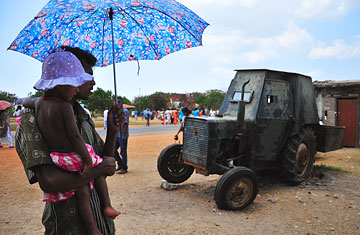
A father and his small child look at an amour plated tractor once used by the Tamil Tigers that now lies in Elephantpass
Elephantpass, a narrow causeway linking the northern Jaffna Peninsula with the rest of Sri Lanka, was the site of many bloody battles during the island's quarter-century civil war. Now it's the site of nation's most famous bulldozer. Covered in iron meshing and armour plating, the mean-looking machine sits on a pedestal, a testament to the over 25 years of conflict that ended in May 2009, and the nearly 80,000 lives lost along the way.
The bulldozer was used by the Tamil Tigers in July 1991 in an attempt to breach the defenses of a Sri Lankan army garrison stationed at Elephantpass. They would have succeeded if it weren't for the actions of government soldier Gamini Kularatne, who lobbed a grenade into its belly, stopping it in its tracks and dying in the act. The war ended 18 years after Kularatne's heroics, when the Tamil Tigers were destroyed by government forces. Since then, the bulldozer has become the most popular stopover point on the A9 highway, a road that runs through the northern Vanni region that was under Tiger control for over a decade until the war's end. Opposite the bulldozer, four more vehicles once used by the Tigers lie close to where they were abandoned in battle, sunlight streaking into the darkened interiors through bullet holes.
Nowhere are the dramatic changes to Sri Lanka since the war's end clearer than on the 100 km stretch of the A9 that runs through the Vanni in the northern Sri Lanka. Once dubbed the highway of death because of the fierce fighting it saw during the war, the A9 is now more like the highway of the insatiable war tourist. Hundreds of buses speed daily on the narrow road, ferrying curious southern visitors to the north for the first time in their lives. What started as a trickle last year has turned into a steady stream; during school holidays, thousands of young Sri Lankans and their families flock to see what they could not for so long.
For the long decades of Sri Lanka's civil war, the south and north were cut off from each other. In the Vanni, the Tigers ran their own administration, and even during ceasefire periods, few southerners traveled on the road leading north. Soon after the conflict reignited in mid-2006 after failed peace negotiations, the region was completely sealed off from the rest of country, leaving the Jaffna Peninsula reachable only by air and sea. The Tigers fought for an independent state for minority Tamils in the north, in the process driving out the few majority Sinhalese and Muslims who lived in areas they dominated.
Many of Jaffna's old residents feel that the northern heartland is struggling to come to terms with the influx of southerners. "The cultural shock is tremendous," says Erabudugoda Piyadasa, a Sinhalese who has lived in Jaffna for six decades."Jaffna and the rest of the north have lived in isolation for so long. It still can't handle the effects of so many visitors." The retired schoolteacher says that one of the biggest surprises has been the dress code of some of the visitors. "Jaffna is still very conservative. When [locals] see women in tight jeans, they are shocked." Still, he says with a laugh, "it is better to be shocked at tight jeans than kill each other over mistrust."
For natives of Jaffna who fled during the war, returning to this ravaged landscape is a surreal experience. "It is hard to explain how I feel. My heart is heavy," says Rani Mangalam, who returned to Jaffna as a tourist after 38 years. "There is so much destruction, so many military, I don't know what to feel." Though the military retains a large presence in the region, the U.N. estimates that over 325,000 civilians who fled the fighting have left the temporary camps to return home or to live with relatives and friends. Some 21,000 people remain at one camp.
For those less attached, Jaffna has proved to be an alluring destination. Though exact figures are hard to come by, on every weekend at least 100,000 to 200,000 visitors flock to Jaffna, according to military officers who register the incoming vehicles. On some weekends, especially during a long holiday or religious festivals, the figures have reached nearly 300,000. "It is clear that the end of the conflict offers enormous growth potential. I see tremendous opportunities in the tourism sector," Ngozi Okonjo-Iweala, the managing director of the World Bank said soon after touring parts of the former conflict zone in eastern Sri Lanka over the weekend.
When the buses carrying the southern visitors enter the Vanni, the travelers' anticipation rises despite being on the road for hours. Passing Omanthai, the line of control that divided government areas and the Vanni until mid-2008, passengers strain their necks out to get their first glimpse of what was for so long the land of the Tigers. Many try to make out the Tiger post that was located just one kilometer from the government line. When the Tigers held sway, all vehicles were checked, travelers registered and goods taxed here. Now there is no sign of the Tiger's de-facto immigration offices, not even blown-out parts of buildings. The shrub jungle has quickly taken over.
